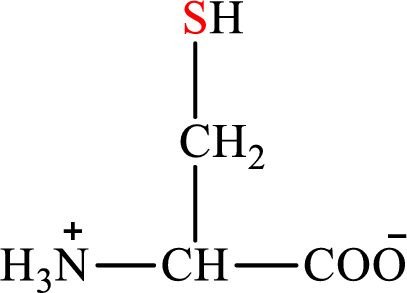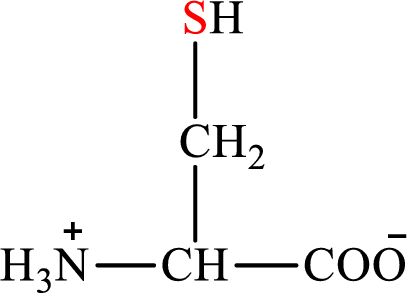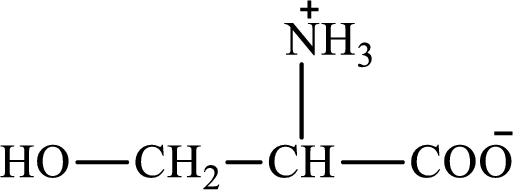
Concept explainers
(a)
Interpretation: To identify whether the statement “four of the 20 standard amino acids contain sulfur” concerning sulfur-containing amino acids is true or false.
Concept introduction: Amino acids are the
There are 20 amino acids present in nature. These are arginine, histidine, isoleucine, leucine, lysine, methionine, phenylalanine, threonine, tryptophan, valine, alanine, asparagines, aspartic acid, cysteine, glutamic acid, glutamine, glycine, proline, serine, and tyrosine.
(b)
Interpretation: To identify whether the statement “the first step in the degradation of the amino acid cysteine is a transamination reaction” concerning sulfur-containing amino acids is true or false.
Concept introduction: There are 20 amino acids present in nature. These are arginine, histidine, isoleucine, leucine, lysine, methionine, phenylalanine, threonine, tryptophan, valine, alanine, asparagines, aspartic acid, cysteine, glutamic acid, glutamine, glycine, proline, serine, and tyrosine. Only two of the twenty amino acids have a sulfur atom in their structure. The two amino acids are cysteine and methionine. The structure of cysteine is:

Cysteine gives pyruvate as the degradation product. The degradation of cysteine is a two-step process.
(c)
Interpretation: To identify whether the statement “pyruvate is the sulfur-containing product from the degradation of the amino acid cysteine” concerning sulfur-containing amino acids is true or false.
Concept introduction: There are 20 amino acids present in nature. These are arginine, histidine, isoleucine, leucine, lysine, methionine, phenylalanine, threonine, tryptophan, valine, alanine, asparagines, aspartic acid, cysteine, glutamic acid, glutamine, glycine, proline, serine, and tyrosine. Only two of the twenty amino acids have a sulfur atom in their structure. The two amino acids are cysteine and methionine. The structure of cysteine is:

Cysteine gives pyruvate as the degradation product. The degradation of cysteine is a two-step process.
(d)
Interpretation: To identify whether the statement “ATP is the activating agent in the first step of the conversion of serine to cysteine” concerning sulfur-containing amino acids is true or false.
Concept introduction: There are 20 amino acids present in nature. Only two of the twenty amino acids have a sulfur atom in their structure. Cysteine is biosynthesized from nonessential amino acid serine. The structure of cysteine is:

The structure of serine is:

Want to see the full answer?
Check out a sample textbook solution
Chapter 26 Solutions
General, Organic, and Biological Chemistry
- a) What is the reason for the non-oxidative phase of the pentose phosphate pathway?b) Which compound is converted into which compound in the step where sequential dehydration and hydration reactions occur in the citric acid cycle?c) Why is ammonia released in some tissues carried by binding to other molecules in the blood? Where is it transmitted in the body for its destruction? What molecule is it transferred onto there? So what molecule does it make?arrow_forwardHow does a ketogenic diet decrease the level of urea in obese patients and increase the level of creatine in obese patients? (explain on a molecular level)arrow_forwardIn transamination reactions, which of the following is not a donor amino acid–acceptor α-keto acid pair? a. aspartate and pyruvate b. alanine and pyruvate c. glutamate and α-ketoglutarate d. aspartate and oxaloacetatearrow_forward
- Which of the following answer choices correctly describes the function of amylase? Select one: a. Cleaves polysaccharides into glucose, limit dextrins, and maltose b. Cleaves each molecule of glucose into two molecules of pyruvate c. Cleaves monosaccharides into glucose, limit dextrins, and maltose d. Cleaves polysaccharides into amino acids, limit dextrins, and monosaccharides at alpha-1-6 branch pointsarrow_forwardThe effect of ATP on the allosteric enzyme PFK-1 is shown below. For a given concentration of fructose 6-phosphate, the PFK-1 activity increases with increasing concentrations of ATP, but a point is reached beyond which increasing the concentration of ATP inhibits the enzyme. (a) Explain how ATP can be both a substrate and an inhibitor of PFK-1. How is the enzyme regulated by ATP? (b) In what ways is glycolysis regulated by ATP levels? (c) The inhibition of PFK-1 by ATP is diminished when the ADP concentration is high, as shown in the illustration. How can this observation be explained? *A graph is included for this question*arrow_forward(a) What amino acid, other than alanine, can be converted by transaminationto a gluconeogenic precursor? (b) Calculate the cost, in ATP equivalents, of converting two molecules of this amino acid to one molecule of glucose.arrow_forward
- The rate-limiting step in fatty acid synthesis is: a. The reduction of the acetoacetyl group to a ?-hydroxybutyryl group b. Formation of malonyl-CoA from malonate and coenzyme A. c. Condensation of acetyl-CoA and malonyl-CoA. d. The reaction catalyzed by acetyl-CoA carboxylase.arrow_forwardAdults who participate in vigourous physical exercise need around 160 g of carbohydrate per day but just approximately 20 mg of niacin for good nutrition. How do you interpret the finding in light of niacin's involvement in glycolysis?arrow_forwardThe pentose phosphate pathway is an alternative pathway of glucose oxidation.(a). Give the two main products of this pathway.(b). Name the enzyme that controls this pathway. The deficiency of this enzyme is sometimes inherited from the parents. What do these patients suffer from?(c). How is this pathway related to nucleotide metabolism?arrow_forward
- Which of these statements about lactate dehydrogenase is true? a.It is a protein. b.It oxidizes lactic acid. c.It reduces another molecule (pyruvic acid). d.All of these are true.arrow_forwardSuppose that, for some bizarre reason, you decided to exist on a diet of whale and seal blubber,exclusively. (a) How would lack of carbohydrates affect your ability to utilize fats? (b) What would your breath smell like? (c) One of your best friends, after trying unsuccessfully to convince you to abandon this diet, makes you promise to consume a healthy dose of odd-chain fatty acids. Does your friend have your best interests at heart? Explain.arrow_forwardProvide the mechanism by which the hormone glucagon can regulate glycogen breakdown in the liver. Once this glycogen is broken down, what is the fate of the reaction product? Which metabolic pathway is it likely to proceed through next and whyarrow_forward
 Human Anatomy & Physiology (11th Edition)BiologyISBN:9780134580999Author:Elaine N. Marieb, Katja N. HoehnPublisher:PEARSON
Human Anatomy & Physiology (11th Edition)BiologyISBN:9780134580999Author:Elaine N. Marieb, Katja N. HoehnPublisher:PEARSON Biology 2eBiologyISBN:9781947172517Author:Matthew Douglas, Jung Choi, Mary Ann ClarkPublisher:OpenStax
Biology 2eBiologyISBN:9781947172517Author:Matthew Douglas, Jung Choi, Mary Ann ClarkPublisher:OpenStax Anatomy & PhysiologyBiologyISBN:9781259398629Author:McKinley, Michael P., O'loughlin, Valerie Dean, Bidle, Theresa StouterPublisher:Mcgraw Hill Education,
Anatomy & PhysiologyBiologyISBN:9781259398629Author:McKinley, Michael P., O'loughlin, Valerie Dean, Bidle, Theresa StouterPublisher:Mcgraw Hill Education, Molecular Biology of the Cell (Sixth Edition)BiologyISBN:9780815344322Author:Bruce Alberts, Alexander D. Johnson, Julian Lewis, David Morgan, Martin Raff, Keith Roberts, Peter WalterPublisher:W. W. Norton & Company
Molecular Biology of the Cell (Sixth Edition)BiologyISBN:9780815344322Author:Bruce Alberts, Alexander D. Johnson, Julian Lewis, David Morgan, Martin Raff, Keith Roberts, Peter WalterPublisher:W. W. Norton & Company Laboratory Manual For Human Anatomy & PhysiologyBiologyISBN:9781260159363Author:Martin, Terry R., Prentice-craver, CynthiaPublisher:McGraw-Hill Publishing Co.
Laboratory Manual For Human Anatomy & PhysiologyBiologyISBN:9781260159363Author:Martin, Terry R., Prentice-craver, CynthiaPublisher:McGraw-Hill Publishing Co. Inquiry Into Life (16th Edition)BiologyISBN:9781260231700Author:Sylvia S. Mader, Michael WindelspechtPublisher:McGraw Hill Education
Inquiry Into Life (16th Edition)BiologyISBN:9781260231700Author:Sylvia S. Mader, Michael WindelspechtPublisher:McGraw Hill Education





